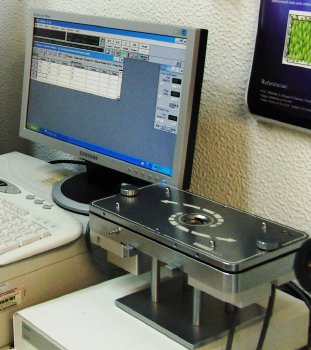Market leaders in temperature controlled microscopy, Linkam Scientific Instruments, have been chosen as suppliers of a CSS450 for the Polymeric and Mesomorphic Materials Group, CENIMAT, Portugal for the rheological characterization of anisotropic materials.
 The Linkam CSS450 set up in the lab of Professor Maria Teresa Cidade of PMMG, CENIMAT in Portugal.
The Linkam CSS450 set up in the lab of Professor Maria Teresa Cidade of PMMG, CENIMAT in Portugal.
CENIMAT is a national scientific research center sponsored by the Portuguese Ministry of Science, Technology and Higher Education. It is divided into four Research Teams: Dielectrics Materials and Structures Group, Electronics and Microelectronics Materials Group, Polymeric and Mesomorphic Materials Group and Structural Materials Group.
The research undertaken in the framework of Polymeric and Mesomorphic Materials Group is focused in the areas of liquid crystals, polymer science and technology. Professor Maria Teresa Cidade, a researcher from this group, is studying the rheological characterization of anisotropic materials.
Anisotropic materials are materials whose properties depend on orientation, such as wood which has a fixed grain, and is stronger in one direction than the other. Professor Cidade says: "The rheological behaviour of the materials under study is closely linked to its orientation and so it is very important to be able to follow the orientation by optical microscopy while under shear. The processing of the materials is dominated by its rheology, so, knowing that the rheological behaviour is dependent on the degree of orientation is crucial for processing design." Some materials undergo a molecular reorganization and orientation due to applied stress and shear which then creates non-linear mechanical behaviour resulting in them being known as complex fluids.
An additional reason these materials are known as complex fluids is because they possess properties similar to both solids and liquids simultaneously. Rheology is being increasingly used to understand the molecular basis for these properties, particularly in materials exhibiting complex behaviour. When Nuclear Magnetic Resonance (NMR) methods are combined with rheology, it can lead to useful information at the microscopic level about molecular organization and dynamics, and at the macroscopic level about the local rate of fluid deformation.
Typically, in rheology a material is subject to deformation and stress. Stress ó(t), is monitored as a function of time dependent strain ã (t). Containment surfaces are used to apply stress causing the fluid to deform under the influence of the relative motion of these two surfaces. The velocity of the field created by the CSS450 can then be observed to understand the exact nature of the deformational flow. The Linkam Optical Shearing System (CSS450) allows the structural dynamics of complex fluids to be directly observed using a standard optical microscope while they are under precisely controlled temperature and shearing conditions. Professor Cidade noted that the CSS450 is both compact and "friendly" to use. A great advantage is the simplicity of the stage which makes it easy for "beginner" researchers to use.
Professor Cidade is mainly looking at cellulose derivatives, such as hydroxypropyl cellulose (HPC), which have useful applications in the foods, cosmetics and pharmaceuticals industries.